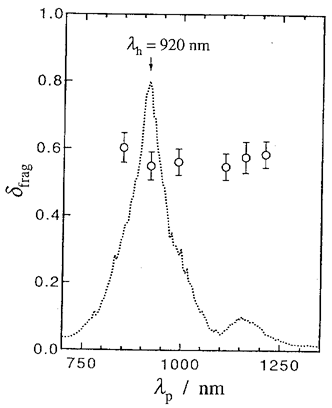
Kazuhiko OHASHI, Yoshiya INOKUCHI (Kyusyu Univ.) and Nobuyuki NISHI
[Chem. Phys. Lett. 263, 167 (1996)]
A pump-probe technique has been developed to study mass-selected cluster ions in the gas phase. The approach allows one to address the question of existence of a number of isomeric forms of cluster ions. Photodissociation of mass-selected ions is used as both pump and probe method. The probe laser is fixed at a wavelength resonant with a transition of an isomer. The intensity of the fragment ion signal generated by the probe laser (probe-laser signal) is proportional to the population of the isomer. The pump laser, preceding the probe laser in time, is capable of reducing the population of the isomer selected by the probe laser. The depopulation is seen as a depletion of the probe-laser signal.
Figure 1 shows the photodissociation spectrum of (C6H6)2+ (dotted curve) in near-infrared region. Both the main band at 920 nm and relatively weak one at 1160 nm are assigned to charge resonance (CR) bands. The issue is whether the two bands are due to two isomers of (C6H6)2+. The pump-probe experiment is performed by fixing the pump-laser wavelength at 920 nm and changing the probe-laser wavelength from 850 to 1210 nm. The intensity of the pump laser is kept at a constant value in a series of the measurement. The depletion yield of the probe-laser signal is plotted against the probe-laser wavelength in Figure 1. The pump laser reduces the intensities of the probe-laser signals by 55-60 % at all wavelengths studied. This finding rules out the possibility that two isomers of (C6H6)2+ are responsible for the appearance of the two CR bands. If the two CR bands were due to different isomers, the depletion yields would be zero at wavelengths in the 1160-nm band region. We therefore conclude that two distinct transitions of a single isomer are responsible for the two CR bands. No evidence is found for the existence of other isomers of (C6H6)2+.

Figure 1. Plots of the depletion yield of the probe-laser signal against the wavelength of the probe laser (open circles). The pump-laser wavelength is fixed at 920 nm. The dotted curve stands for the photodissociation spectrum of (C6H6)2+.